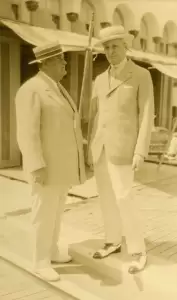Entertainment Around the County

Entertainment started to evolve into culture in 1918. The Woman’s Club in Palm Beach held what may have been the county’s first formal art exhibition and began the annual Art Day of the Woman’s Club shows. The Palm Beach County Art Club was formed in 1920 as an offshoot of the Woman’s Club.
In 1926 Florenz Ziegfeld opened the Club de Montmartre restaurant-theater, with financial backing from Paris Singer and Anthony Biddle, Jr. The first year Ziegfeld staged Palm Beach Nights, the only of his Follies not to originate on Broadway, then reopened it in New York as No Foolin’. The show’s hit song, “Florida, the Moon and You”, became Palm Beach’s theme song. Ziegfeld’s club was popular until the Depression hurt him financially.
Florenz Ziegfeld and architect Joseph Urban were behind the opening of The Paramount Theatre in the Sunrise Building in 1927, which Urban designed. The Paramount presented movies as well as live performancers, including Al Jolson, George Jessel, and Eddie Cantor. It is now used as office and retail space.
The Romany Chorus was founded by baritone John Charles “Romany Tom” Thomas in 1928. The singers performed frequently at the Bath and Tennis Club, the Everglades Club, and The Breakers.
In 1924 Carl Kettler, Jr. replaced his Bijou theater at Narcissus and Clematis with the 1,400-seat, $500,000 Kettler Theater to honor his father, Carl Kettler, Sr., former secretary to actor Joseph Jefferson. The theater, hailed as “the finest structure south of Atlanta,” showed one of the first color talking movies in 1929. The site is now a parking lot.
The Sunset Cocktail Lounge on 8th Street in West Palm Beach opened in 1926 on the roof of an auto repair shop, and soon took over the entire building. Performers who appeared at the Sunset included Duke Ellington, Count Basie, Louis Armstrong, and Ella Fitzgerald.
In Lake Worth, brothers Lucien and Clarence Oakley opened the Oakley Theatre, now the Lake Worth Playhouse, on Lake Avenue in 1924. The Oakleys rebuilt the theatre after it was nearly destroyed in the 1928 hurricane, but lost ownership of it during the Depression.
WJNO, now a radio station at 1290 AM, was a CBS affiliate when it went on the air in 1936. During World War II, a poll showed that 94% of the radios in Palm Beach, West Palm Beach, and Lake Worth were tuned to WJNO, then at 1200 AM and the only signal between Orlando and Miami.
From the 1920s into the 1950s, cartoonists formed the nucleus of an artists and writers colony in Delray Beach. Starting in 1927 with H. Y. Webster, comic strip artists formed a colony in Delray Beach that lasted into the 1950s. Seasonal resident Fontaine Fox, writer of the syndicated “Toonerville Trolley” comic strip, had an office above the former Tap Room. W. J. “Pat” Enright, formerly a cartoonist for the Democratic Party, moved to Delray Beach in 1934 and became a political cartoonist for the Miami Herald and Palm Beach Post. Cartoonist Herb Roth visited in the 1930s and ‘40s; he recorded the events of World War II in the Delray News.

